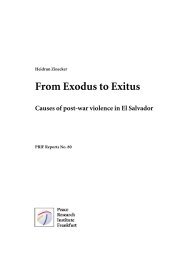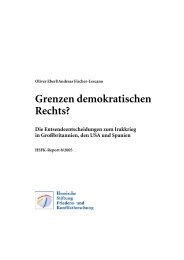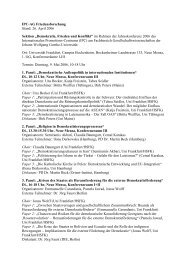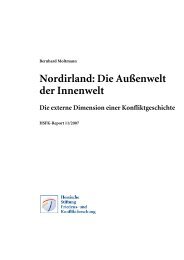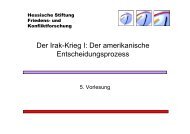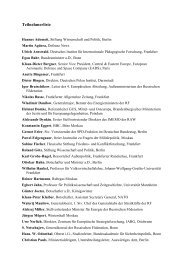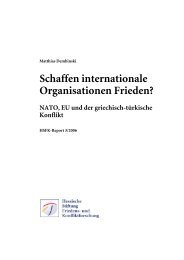The Normative Construction of the Military in Lithuania - HSFK
The Normative Construction of the Military in Lithuania - HSFK
The Normative Construction of the Military in Lithuania - HSFK
You also want an ePaper? Increase the reach of your titles
YUMPU automatically turns print PDFs into web optimized ePapers that Google loves.
M<strong>in</strong>iotaite: <strong>Lithuania</strong>n Case I/14-2007<br />
expansion <strong>in</strong>to Russian lands <strong>in</strong> <strong>the</strong> East, <strong>the</strong> latest be<strong>in</strong>g affected by a series <strong>of</strong> victories<br />
aga<strong>in</strong>st <strong>the</strong> Tatars and a policy <strong>of</strong> judicious <strong>in</strong>termarriages with Russian pr<strong>in</strong>cely<br />
families”.5 Such an expansionary policy required a well-armed pr<strong>of</strong>essional army that<br />
was recruited from different ethnicities liv<strong>in</strong>g on <strong>the</strong> territory <strong>of</strong> <strong>Lithuania</strong> at <strong>the</strong> time. In<br />
<strong>Lithuania</strong>’s contemporary political perceptions, <strong>the</strong> dual character <strong>of</strong> <strong>the</strong> policies <strong>of</strong> that<br />
time f<strong>in</strong>ds its reflection <strong>in</strong> be<strong>in</strong>g proud <strong>of</strong> <strong>the</strong> heroism <strong>of</strong> <strong>the</strong> defenders <strong>of</strong> ethnic land, but<br />
also <strong>in</strong> <strong>the</strong> admiration for <strong>the</strong> pr<strong>of</strong>essional army for its victorious exploits <strong>in</strong> conquer<strong>in</strong>g<br />
new territories (expand<strong>in</strong>g one’s security space, <strong>in</strong> current jargon). One can say that<br />
<strong>Lithuania</strong>’s medieval history legitimizes both <strong>the</strong> image <strong>of</strong> warrior-defender and that <strong>of</strong><br />
<strong>the</strong> warrior-conqueror. However, <strong>the</strong> formation <strong>of</strong> <strong>the</strong> image <strong>of</strong> <strong>the</strong> contemporary military<br />
was most directly affected by <strong>the</strong> experience <strong>of</strong> security and defense policies <strong>of</strong> <strong>in</strong>terwar<br />
<strong>Lithuania</strong> (1918-1940) and by <strong>the</strong> story <strong>of</strong> <strong>the</strong> formation and <strong>the</strong> collapse <strong>of</strong> its military.<br />
1. <strong>Lithuania</strong>’s Armed Forces: <strong>The</strong>ir Role and Status <strong>in</strong> <strong>the</strong> First<br />
Republic (1918-1940)<br />
1.1. Historical and Geopolitical Background<br />
<strong>Lithuania</strong> declared its <strong>in</strong>dependence <strong>in</strong> 1918, <strong>in</strong> <strong>the</strong> aftermath <strong>of</strong> <strong>the</strong> war and <strong>the</strong><br />
revolutions that led to <strong>the</strong> collapse <strong>of</strong> <strong>the</strong> Russian empire. 6 <strong>The</strong> ma<strong>in</strong> goal <strong>of</strong> <strong>the</strong> new state<br />
at that time was to def<strong>in</strong>e, and to secure <strong>in</strong>ternational recognition <strong>of</strong> its territorial borders.<br />
At <strong>the</strong> time <strong>Lithuania</strong> had borders with Latvia, Poland and Germany.<br />
In a book published <strong>in</strong> 1938, commemorat<strong>in</strong>g 20 years’ anniversary <strong>of</strong><br />
<strong>Lithuania</strong>’s <strong>in</strong>dependence, <strong>Lithuania</strong> was characterized as <strong>the</strong> country “struggl<strong>in</strong>g for<br />
Vilnius” 7 . <strong>The</strong> problems relat<strong>in</strong>g to Vilnius were raised at <strong>the</strong> Paris peace conference. <strong>The</strong><br />
goal <strong>of</strong> <strong>Lithuania</strong>n political leaders was <strong>the</strong> restoration <strong>of</strong> <strong>in</strong>dependent <strong>Lithuania</strong> <strong>in</strong> its<br />
ethnic boundaries, with Vilnius as capital and with <strong>the</strong> area <strong>of</strong> <strong>the</strong> Smaller <strong>Lithuania</strong><br />
(Konigsberg region) <strong>in</strong>cluded with<strong>in</strong> its boundaries. <strong>The</strong> goal clashed with Poland’s<br />
<strong>in</strong>terests <strong>in</strong> its endeavor to re-establish Poland with<strong>in</strong> <strong>the</strong> boundaries <strong>of</strong> 1793. Thus it<br />
claimed Vilnius and <strong>the</strong> Klaipeda (Memel) region, <strong>the</strong> same territories as did <strong>Lithuania</strong>.<br />
In an attempt to streng<strong>the</strong>n its position <strong>in</strong> <strong>the</strong> negotiations with <strong>Lithuania</strong> Poland seized<br />
Vilnius on October 9, 1920. In 1923 <strong>the</strong> League <strong>of</strong> Nations resolved to cede Vilnius to<br />
Poland, while recogniz<strong>in</strong>g <strong>Lithuania</strong>'s claims to <strong>the</strong> Klaipeda region. Despite <strong>the</strong><br />
5 See David J. Smith, Artis Pabriks, Aldis Purs and Thomas Lane, <strong>The</strong> Baltic States: Estonia, Latvia and<br />
<strong>Lithuania</strong>, London and New York: Routledge, 2002, p. XX.<br />
6 In 1565 <strong>the</strong> Lubl<strong>in</strong> union between <strong>the</strong> Great Dukedom <strong>of</strong> <strong>Lithuania</strong> and <strong>the</strong> K<strong>in</strong>gdom <strong>of</strong> Poland was<br />
created, constitut<strong>in</strong>g <strong>the</strong> Commonwealth <strong>of</strong> <strong>Lithuania</strong> and Poland. In 1793-95 <strong>the</strong> Commonwealth was<br />
broken up and absorbed by Russia, Prussia and Austria. <strong>The</strong> entire <strong>Lithuania</strong>n ethnic area fell under<br />
Russian rule. It rema<strong>in</strong>ed so until <strong>the</strong> end <strong>of</strong> <strong>the</strong> First World War.<br />
7 See: Zaunius, D. (19380 ‘Du Lietuvos uzsienio politikos desimtmeciai’, <strong>in</strong> V. Kemezys (ed.),<br />
Lietuva 1918-1938, Spaudos fondas, Kaunas, p.30.<br />
3



